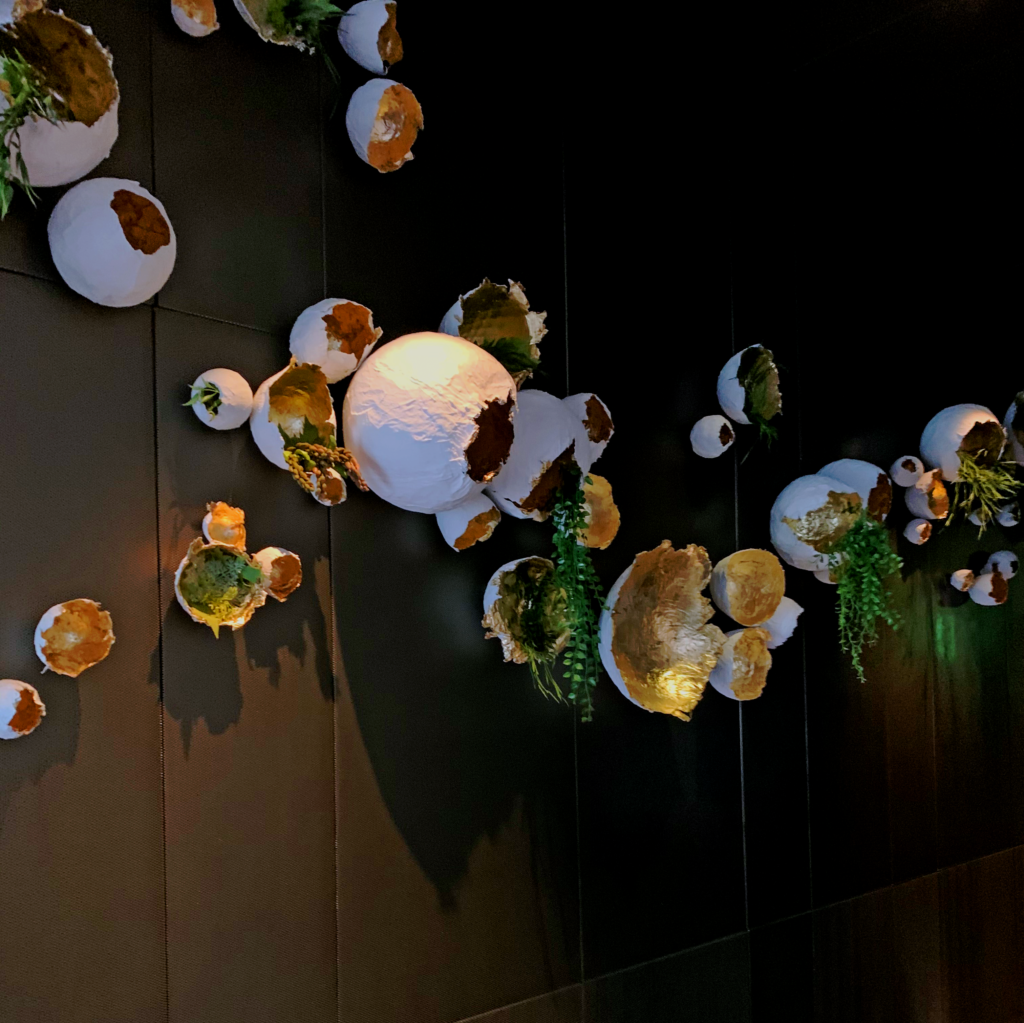If the eyes are the window to the soul, then the soul must be theengine of hospitality. Not the mechanical side of service, mind you, whichconcerns itself with timing, technical mastery, and the memorization of any andevery detail that could possibly concern the guest. Rather, the eyes provide apathway towards sensing sincerity—that is, the spark of an emotional connectionwhich can form when a host or hostess places someone in their care and thatsomeone, thoroughly present and engaged in the experience, emits dueappreciation in return.
“Smile more,” so goes the stereotypical advice, and, in the era beforeface coverings, that was often enough. The American consumer is king (or, atleast, they still feel that way), and the king’s subjects—however filled withfear or disdain they might be under the surface—had better not rain on hismajesty’s parade. To wit, in most retail or hospitality settings, any givenemployee is merely a mediator between the customer and their chosen product.Any given manager, likewise, is simply a conduit towards receiving betterservice, a discount, free stuff, or—perhaps—is just a punching bag on someone’sbad day. One can tell, especially among those one is closest to, when a smileexpresses pure joy or, otherwise, is only put on. However, the nature ofsmiling in hospitality settings—both for staff and for customers—is so routineand so performative that all ultimate meaning has been stripped from thegesture.
These smiles may sometimes be sincere, sometimes not, but both partieshave endeavored to accept the signal at face value: “I am happy, you are happy,there is no problem here.” No fussy customer has ever, you think, taken issuewith the genuineness of the gesture. It is, in some final sense, a show ofsubmission (and one, perhaps, for a particularly cruel sort of person, that providesan added pleasure when it contradicts one’s internal state). Just the same, nohospitality professional has ever probed a patron’s sheepish grin for thenegative emotion it might be obscuring. You often find yourself reporting thata dish was “good” or “pretty good” when it may have only been average (orworse). In contrast, a truly great dish inspires an outpouring of emotion—ofnaked pleasure—that could not easily be faked. In this way, you rely on thestaff to read between the lines while they respect your right to avoid outrightcriticism. The smile, thus, becomes a shorthand for “everything is okay.” Itestablishes the baseline of the experience whereas the eyes offer somethingmore.
You felt inspired to write this article after a rousing meal at Yūgenthis past weekend. The restaurant, which was somewhat born out of controversy,did well to earn its Michelin star last year. It took its time reopening duringthe pandemic, yet executive chef Mari Katsumura has struck upon threethoughtful concepts that are among the most exciting in Chicago at the moment:a take on a “grab and go” Japanese convenience store in their former loungespace, a tiki / yakitori menu on their new patio, and the latest iteration of Yūgen’stasting menu in their redesigned dining room. The food and drinks you tasted onboth the patio and the tasting menu were impeccable. Katsumura has shownincredible growth and refinement in her flavors since the restaurant’sopening—not to mention a sense of playfulness and an overall aesthetic that isfirmly her own. You think she is already getting closer to that second Michelinstar, and, notwithstanding that, Yūgen is one of only few restaurants (along with Kyōten, Topolobampo,and Ever) that have found a way to offer more unique and luxurious experiencesduring the pandemic (rather than compromising creative values for the sake ofwider appeal).
Yūgen’s success comes on the back of unerring service under the commandof a newly-hired service director who cut his teeth at Eleven Madison Park,Gabriel Kreuther, and Sushi Nakazawa in New York City. Yet this director, asestimable as the hospitality he rendered was, did not inspire this article.Rather, it was your captain that evening, a woman whom you think had been withthe restaurant since before the pandemic, whose service struck you.
In a dining room such as Yūgen’s—one with the requisite ambiance andaspirations to be termed bonafide, formal fine dining—sleekly-suited serversoperate at the pinnacle of technical mastery. They pour drinks and pull outchairs in total synchronization. They pour sauces to garnish dishes and evenshave truffles (being careful to appear generous but not profligate). As adiner, seeing the staff whirl around in such a way impresses upon you thefeeling of sitting at the center of a well-crafted watch. The mechanics areunerring, dependable, but might they be cold? Does the deferential nature ofsuch subdued, exacting service deny any chance for a human connection to comeforth? The secret is in the eyes.
While the “customer service smile” has already been stripped almostentirely of any emotional weight, face coverings have further denied diners thechance to forge a connection with their caretakers. Pre-pandemic, it was easyfor both parties—customer and server—to get by with half glances and mumbledpraise. Facial gesture, at the macro level, told everyone what they needed toknow: “smile = GOOD EXPERIENCE” or “frown = BAD EXPERIENCE.” (Perhaps, youwould also include “smile = GOOD SERVER” and “frown/smirk/visible frustration =BAD SERVER” from the diner’s perspective).
Hospitality professionals, of course, retain the benefit of observingtheir guests’ expressions at the table from behind their own masks. This is nota question of communication, for which superficial smiles and frowns do justfine. Rather, you talk of the deeper bond between “server” and “served,” theeternal dance of hospitality, of hosting someone as if he or she were in yourown home. It is a question of both sides, thoroughly present, giving fully ofthemselves and sanctifying something precious: full appreciation of the moment,of nature, and humanity’s place therein.
Some restaurants, such as Smyth, embrace a conversational style ofservice that allows for each individual employee’s personality to shineorganically. The mood in these kinds of dining rooms is not intimidating or dramatic.Instead, the nature of the experience is one of overwhelming warmth and comfort.The servers, empowered to express themselves, invite the same from theirguests. Add incredible food and wine to the mix, and one has a recipe for apeak hospitality experience—masks or no masks.
Restaurants such as Yūgen, in contrast, opt to create spaces that areabstract and minimalist. It is a stylistic choice, and one that forms a fittingpartner for certain cuisines. These restaurants prize the sort of faultlessprecision you mentioned earlier, and the synchronization that is so pleasing tothe eye demands that staff constantly remain at the ready to deliver it. Warmthis not discouraged—and, in truth, interactions are unerringly pleasant—butconversational ease and flow often suffers when a restaurant’s service priorityis to hit all the performance marks for all the tables all the time. In theserestaurants, the chef, as well as managers and sommeliers, may be moreempowered to loiter and provide that extra-special personal touch. However,captains and servers—however pleasant—may come across more like automatons in theirfacilitation of the meal’s larger artistic goals. The cuisine is the mainevent, and they are merely the stagehands that keep the show on the road.
This is all well and good, and a “hands off” approach can certainlylend itself to special meals where all the action is focused on the table. Thediners’ own conversations with each other can be quite fulfilling in their ownright too. Nonetheless, in denying a deeper understanding between the “server”and “served” to flourish, the restaurant runs the risk of becoming a mere meansto a fundamentally consumptive end. At what point, then, does the servers’ roletransform from delivering food, from guiding you down the typical track of the “guestexperience,” into something transcendent? The secret, especially at this momentin time, is in the eyes.
There may no longer be any opportunity for servers to stay at yourtable and make small talk—that is, to engage in the little niceties whichillustrate some piece of each individual staff member’s soul. Likewise, facecoverings—as you have described—deny diners any chance at appraising thesincerity of a server’s smile. (Not that such a signal can be relied upon tostare into someone’s soul, yet you like to think certain facial expressionsemit an unmistakable pride and genuine presence that strike to the emotionalcore of hospitality).
No, in this day and age we may only rely on reading those two irises,those two pupils, peeking out at us from their perches atop a surgical mask. Dothose eyes dart towards the next table as the your interaction ends, or do theylinger? Are those eyes strained? Do they anxiously await whatever request couldbe coming, or do they glisten with warmth, with ease, with the promise thatnothing in the world (let alone the restaurant) could be more important thanyou at this very moment? Do the eyes pierce you with their honesty, their vulnerability?Do they strike your own eyes, quieting your mind and making quite clear—justfor a moment—that this being before you is a kindred soul? Your captain thatevening at Yūgen possessed such a set of eyes, and they electrified everyinteraction—however minor—throughout the meal.
In the age of airborne viral transmission, the relationship between “server”and “served” has never been more consequential and, ironically, impersonal. Youare asked to place your life in the hands of someone you cannot really see. Thetrust one implicitly gives to the chef handling the ingredients on theirtasting menu now must extend to each and every member of the team. At a timewhen fine dining forms the most frivolous of luxuries, mechanical perfectionbecomes the expectation—for your life and their livelihood depend on it. Thehuman element—formerly often ignored—is now highlighted as a vector ofinfection. Now we do want to be served by robots: sterile, precise,impeccable.
But we do not have that luxury. We must trust and be patient with eachother, particularly those in the hospitality industry. We must acknowledge thatwe bear the risk of going out not for mere food but, principally, to supportthose who have made caring for us their calling. Do that, and you may besurprised that, in these darkest of days, the true soul of hospitality finds away to shine through.





